|
I've been thinking about how in several different tales, a Thumbling figure becomes a favored servant of a king.
Tom Thumb becomes King Arthur's dwarf and one of his favored knights. (In later versions, he runs afoul of the queen.) Issun-boshi acts as a samurai for a daimyo, or feudal lord. The Hazel-nut Child, in a tale from the Armenian people of Romania, Transylvania and the Ukraine, makes his way to the palace of an African king. Like Tom Thumb carrying home a coin for his parents, the Hazel-nut Child brings home a diamond given to him by the king. Karoline Stahl (the same woman who wrote the first version of Snow White and Rose Red) wrote a story called Däumling. Daumling goes to live in the palace, where he serves the king and several times defends him from assassination attempts. The story was probably inspired by the British Tom Thumb. Both stories have an emphasis on the main character's clothing and needle- or pin-sized sword, as well as an evil queen. Sometimes the thumbling's encounter with the king isn't quite so pleasant. In numerous tales, the thumbling is out in the field with his father, when a rich man, sometimes a noble or king, sees him and asks to buy him. The thumbling sells himself and then runs away, cheating the rich man. In one version, Neghinitsa, the main character does not run away, but ends up working as a king's royal spy until his death. In other stories, like the German "Thumbling as Journeyman," or the Augur folktale "The Ear-like Boy," the Thumbling becomes a robber and a king is one of his victims. In a tale from Nepal (printed in German), the thumbling steals items from the king's palace and eventually wins the hand of one of the princesses. Also in "Thumbling as Journeyman," the little thief takes a single kreuzer, stolen from the king's treasury, to give to his parents back home. Here again is the same motif as Tom Thumb, where the tiny knight asks King Arthur for permission to take one small coin to his parents. In other stories, Thumbling marries the king's daughter - a common ending for fairytales. Issun-boshi marries the daimyo's daughter. In the Philippines, Little Shell and similar characters pursue the daughter of a chief. (See blog post.) In India, Der Angule completes many tasks for a king and finally marries the princess. Some retellings of Tom Thumb, such as Henry Fielding's play, have him woo a princess. I worked a little bit on a chart comparing some of these stories. I included the Grimms' Thumbling among "trickster tales." EDIT: Now with new and improved chart!
0 Comments
I found a new Thumbelina! Baratxuri is one of several Basque characters, the only girl among them. She has the typical Thumbling adventures, which is, ironically enough, rare for a female thumbling. She takes food to her father in the field, rides ina donkey's ear, and frightens off thieves.
I found it interesting that her name means "garlic." In that respect, she's the same as Maria como un Ajo, or "Mary like Garlic," from Cantabria in Spain. She has exactly the same adventure as Maria, too. Here is a quick list of the notable thumbelinas I found: Llagoreta-tomate (Catalonia) Draganka or Katsmatsura (Bulgaria) Nammulah (Palestine) Doll i' the Grass (Norway) Nàng Út (Vietnam) Terra-Camina (France) The Little First Man and the Little First Woman (Dakota) The Daughter of the Laurel Tree (Barcelona) Ditu Migniulellu (Corsica) Finger-Joint (Egypt) Katanya (a Jewish tale from Turkey) Lentil (Kuwait) In comparison to the vast list of male thumblings, this is very short. Finding thumbelinas was part of the reason I started this project. This is why I get so excited when I find a new one. Thumbelinas are much more likely to fall into other tale types, like the Animal Bride tale type. I think their scarcity says something about these cultures; when the childless couple prays for a child it is quite often specifically a son that they ask for. Female thumblings are also more likely to grow to full size, like the Japanese Kaguya-hime. References
If you're a fan of King Lindworm and other beastly bridegroom tales, check out Jenny Prater's blog Halfway to Fairyland. I've been enjoying it.
Now, on to the analysis! Little Shell is a tale from the people of the Visayan Islands, one of the three main divisions of the Philippines. Retold by Elizabeth Hough Sechrist, it's a unique variation on the Thumbling tale, but still has many recognizable elements. The story begins like many thumbling stories. A man and a woman, after many prayers, have a son no bigger than a seashell. When he grows a little older, the boy - known as Little Shell - begs his mother to allow him to go out on his own and work. He crawls into a woman's fish basket and shouts, "Run! Run!" Thinking that her fish have been bewitched, the frightened woman runs off, allowing Little Shell to make his exit with one of her fish, which he takes home to his mother. He plays a similar trick on an old man carrying a cow's head (cow's heads have good meat on them). Hearing Little Shell shouting, the old man thinks that the cow's spirit has returned to haunt him, and flees. Little Shell asks his mother to go to the chief or headman, and request the hand of his daughter in marriage. Although the headman immediately refuses, his daughter agrees to the union. Shell's mother is astonished; the headman is furious, and Shell and the princess are forced to flee. They live together, but are unhappy in exile. However, after one week, Little Shell grows to normal size. It turns out he was enchanted by an evil spirit at birth, and the princess's love has broken the spell. They return home, the headman is ashamed of his behavior, and everyone lives happily ever after. Sechrist drew this story from "The Enchanted Shell," which appeared in Visayan Folk-tales, II, in the Journal of American Folk-Lore in 1907. These folktales were prepared by researchers Berton L. Maxfield and W. H. Millington during their stay in the Visayan Islands. They collected them in Spring 1904, on the island of Panay. Teachers and students at schools in Iloilo and Mandurriao contributed stories. "The Enchanted Shell" has some minor differences. Rather than telling the woman to "Run! Run!" Shell tells her "Rain! Rain!" There is also a specific location named - "a desert place called Cahana-an." Specific location names are always interesting. The phrasing is a little confusing; Maxfield and Millington's Shell is "very small, and just like a shell," and at some points he's referred to simply as "the shell." It seems Sechrist adapted this as she felt best. However, thumbling characters can be small animals or objects. The enchanted shell does several things typical to a thumbling story. He's born as the result of a hasty wish; he goes out to do work despite his small size; he's a trickster; he climbs into an animal's ear. It's possible some aspects of this story came from European colonizers. I do think it's important to note that Maxfield and Millington say that all of the stories they published were very widespread in the Visayan islands, and everyone seemed to know them. The revelation about an enchantment seems to come from nowhere, almost as if there's a part of the tale which has been lost. The romance plot, on the other hand, reminds me of Issun-Boshi and the Japanese family of thumbling tales. Japan and the Philippines have had relations for centuries, with trading going back at least to the 1600s and to the Muromachi period. Issun-Boshi and Little Shell could perhaps share roots. The Living Head, another Visayan tale, is very similar - at least at the beginning. Here, the childless couple produces not a shell or a tiny baby, but a disembodied head. The head, imaginatively named Head, sees the chief's daughter and falls in love with her. He sends his mother to ask for the princess's hand in marriage. Like Little Shell and his mother, they argue back and forth, but the mother finally goes to ask the chief. However, in this case, she gets a solid no. When Head hears the news, he begins to sink into the ground. His mother calls him to dinner, but he only cries, "Sink! Sink! Sink!" He disappears into the ground, and from that spot grows the first orange tree. A final relevant tale from the Philippines is the Bagobo tale "The Woman and the Squirrel." The Bagobo people live in southeastern Mindanao. This story was collected in 1907; collector Laura Watson Benedict noted that the myths were specifically those that hadn't been recorded yet, they were told in mixed English and Bagobo, and they were collected from "Mount Merar in the district of Talun, and at Santa Cruz on the coast." A woman drinks some water from a leaf. She goes home and falls asleep for nine days, and when she wakes up and begins to comb her hair, a baby squirrel emerges from it. This type of unusual conception is not unusual in fairytales (see Nang Ut and the Miraculous Birth). The squirrel grows to maturity and a week, and tells his mother that he wants to marry the chief's daughter. Despite her protests, he sends her off to the chief's house with nine necklaces and nine rings as a dowry. She chickens out and comes back without asking, so the squirrel bites her (!). Finally, she makes her request. In response, the chief tells her that he wants his entire house turned to gold. She relays this to her son the squirrel. That night, the squirrel goes out and calls to his brother, the Mouse. The "great Mouse" has golden fur, and his eyes are glass. He gives the squirrel a bit of his fur, which the squirrel uses to turn the sultan's house and possessions completely into gold. When the chief wakes up and sees that his impossible request has been granted, he dies of shock. The squirrel then marries the princess, and after a year, he takes off his skin and becomes a handsome young man. "The Enchanted Shell," "The Living Head," and "The Woman and the Squirrel" form a tale family of their own, with a romantic aspect that runs through all three stories. A woman gives birth to a small and monstrous son, who sets out to marry the daughter of a chief. Whether he succeeds or not - that's another story. Another thumbling figure from the Philippines is Carancal, a Young Giant-type character who is born only one span tall. That, however, is a very different tale. Resources
Niraidak is a tale from Siberia, told by the Evenks. This is probably one of my favorite Thumbling tales. The main character is actually larger than a thumb, but the word "thumbling" can be used for small characters in general, including characters who are one span high, or the size of a bird, or what have you. "Tough Little Niraidak" is included in Margaret Read MacDonald's Tom Thumb book and in Irina Zheleznova's folktale collection Northern Lights.
The story takes place at the beginning of time, when the sky was still being woven. On the island lives a tiny man named Niraidak. Where he came from, the tale doesn't explain. "A squirrel to him was as big as a fox to an ordinary man, a doe as big as a moose, and the tiniest bird as big as an eagle." It seems like he's closer to the size of a baby than the size of a thumb. In this respect, he's more similar to the Native American child-sized heroes Boy-Man and Tshakapesh (see blog posts here and here). However, his small size is a major part of the story and there are many descriptions of his clothes and so on. This is one of my benchmarks for whether a tale is a thumbling story or not. His tent is made of rose willow twigs and squirrel skins, his gloves are made from mouse skin, his hat from a mole skin, and his coat from two sable skins. For reference, sables are 15-22 inches long. Niraidak is totally alone except for his steed, a small hornless deer. He survives by hunting. Hunting was the traditional livelihood of the Evenki people, as well as herding reindeers for riding, carrying packs, and milking. I believe Niraidak's deer is a Siberian musk deer, which grows tusks instead of antlers. Musk deers are an endangered species, and adults weigh from 15 to 37 pounds and stand 20-28 inches at the shoulder. Since Niraidak has no one to compare himself to, he gradually begins to believe that he must be the biggest and strongest person in the world. Eventually, he decides to do three things: see how other people live, fight a giant, and marry the most beautiful woman in the world. He summons the deer and tells it to turn into a flying, fire-breathing boar. Apparently it can do this. So he rides off on his flying boar (formerly a deer). First, they set out to see how other people live. In Zheleznova's version, the boar tramples everyone they come across, while Niraidak takes no notice; MacDonald leaves this out. Eventually, they come across a massive giant named Dioloni, or "man of stone." (The Evenk word for stone is d'olo.) When this happens, you might expect a fight similar to that in David and Goliath or Jack the Giant Killer. Niraidak certainly does. However, when the giant notices Niraidak (whose stealthy approach has been impeded by tripping on a twig), he picks him up. The giant seems fairly benevolent, but Niraidak is ready to fight. “I am the great Niraidak,” the little man squeaked. “I have no fear of you, Dioloni the Giant. Beware, for I am going to slay you.” He then begins screaming and jumping up and down in order to intimidate his foe. The giant, understandably, just thinks this is hilarious, and puts Niraidak in his pocket. Niraidak decides to cut his losses, crawls out, and flies off on his boar again with a final boast: “Take care, Dioloni the Giant, next time I’ll skin you and crush your bones to dust!” They travel on to a camp "where the most beautiful women in the world lived." Apparently all the women hear Niraidak's bragging (or maybe see his magic boar) and are quite impressed, because they quickly line up to take their chances. Niraidak picks out the most beautiful one and takes her home on his boar. However, he immediately realizes that his tent (made of three squirrel skins, remember) is far too small for his new wife, a normal-sized woman. He builds a new one that will fit her (which to him, of course, is incredibly spacious). Then he goes to fish, and comes back bearing a massive load of twenty-five fishes, so much that he can't carry them all and has to ask his wife for help. She's excited at first, but when she actually sees his catch, is outraged. They're nothing but minnows! She eats them, but still feels hungry and begins to scream at Niraidak. In response, he tells her to lie down, puts a rock on her belly so she won't feel hungry, and heads into the woods. While he's gone, the wife starts reconsidering her life choices. So: "off she went to a village where there lived strong and considerate men who did not refuse their wives anything they asked." For his part, Niraidak isn't particularly upset to find his wife gone; now he has a big tent all to himself, and no one's screaming at him about food. So he lives happily ever after. This short, straightforward tale is full of parody. I particularly like the bit about the "strong and considerate men." Niraidak is both perpetually cheerful and filled with delusions of grandeur. He is a fierce hunter in his own mind, unable to grasp that he is really the weakest person around. His feats are impressive only from his own skewed perspective. (Well, except for the transforming fire-breathing boar.) Niraidak sets out to complete three tasks, but none of them go quite the way he expects. They turn out more as embarrassments than triumphs. He remains upbeat, but never seems to mature or gain any self-awareness. As he sneaks off from Dioloni, he still boldly threatens him. After his wife leaves, he happily takes up his old life again. He doesn't change. References
The Grimms published two tales that were very similar: Thumbling (Daumesdick) and Thumbling's Travels (Daumerling's Wanderschaft). Although they're both commonly referred to as Thumbling, these are not the same character. 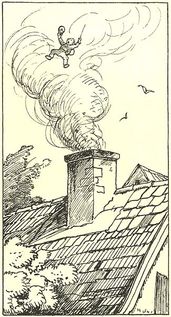 Thumbling begins his journey. Hermann Stockmann (1867-1938). Thumbling begins his journey. Hermann Stockmann (1867-1938). Thumbling's Travels, or Thumbling as Journeyman begins with Thumbling telling his father, a tailor, that he wants to go out into the world. He takes a darning needle for a sword. Before he can do anything else, he's blown up the chimney on the steam from a hot meal. When he lands, he goes to become a tailor's apprentice, but is displeased with the food. He mocks the cook, telling her, "I will go away, and early to-morrow morning I will write with chalk on the door of your house, 'Too many potatoes, too little meat! Farewell, Mr. Potato-King.'" She does not react well. Taking up his journey again, he joins a band of robbers and they rob the king's treasury. The impressed robbers want to make Thumbling their captain but he wants to see the world first. He goes on his way, taking only one kreuzer (a small silver coin) because it's all he can carry. He takes a job as a manservant at an inn, but snitches on the maids when they steal food. A vengeful maid catches Thumbling in the garden and gives him to the cows with the grass clippings, causing him to be swallowed. When someone milks the cow, Thumbling calls, "Strip, strap, strull, will the pail soon be full?" They slaughter the cow, and Thumbling is sealed into a black-pudding or sausage and hung up all winter. He only escapes when someone cuts it open. Once outside, he is swallowed by a fox, and promises to let it eat the chickens in his father's yard if it will take him home. This happens, and Thumbling is reunited with his overjoyed father, who doesn't mind the fox eating his chickens now that he has his son back. The end. The hero being a tailor suggests a connection to the story of the Brave Little Tailor. There are actually many songs and jokes about tailors being very small or thin. In Eucharius Eyering's Sprichwörter (1601), a tailor as light as elder-wood is blown into the air and gets caught in a spider's web. There is one folk song about a tailor falling into a soup bowl and being swallowed, and another about tailors feasting on a fried flea and drinking out of a thimble - for the second, see "Nine Tailors Held a Council" by William Davis Snodgrass. SurLaLune's annotation of the Brave Little Tailor explains, "tailors were poor and not highly regarded by society because they were seen as weak men." Because of the Industrial Revolution and the decline of guilds, tailors were poor and travelled around. Townspeople saw these wanderers as shifty, lazy and dishonest. As seen in this German list of idioms, there were sayings like "freezing like a tailor" for oversensitivity to cold, and "eating like a tailor" for not eating very much. The weakness of tailors was attributed to a lack of food and it was said they couldn't bear much in contrast to the strong appetite of the agricultural workers. The Schneider-Geiß-Spott or Schneider-Spottlied (tailor-mocking) was a specific type of German joke which originated as a crude sexual gag. These date back to at least 1408, when a Strasbourg council banned such a joke. The Grimms' tailors, however, are courageous, clever tricksters. Cleverness is the most esteemed virtue in Grimm tales. Thumbling is called a journeyman, meaning he's completed his apprenticeship but is not a master tailor. Like all the Grimms' stories, Thumbling's Travels changed in the telling. The first edition preserves the stories more exactly as they were first told. Later editions, after the stories became popular, soften unsavory elements and polish the plots. Wilhelm was the principal editor after their first edition, and revised the tales extensively to make them more dramatic and literary. In The 1810 Grimm Manuscripts, Oliver Loo compares the Grimms' first edition from 1812 with an earlier surviving draft. There are some small differences, mostly literary embellishments and polishing. The original edition lacked the "Farewell, Mr. Potato King" and indeed any mention of potatoes. Jacob and Wilhelm heard the potato line from a maid, completely separately from the tale, and Jacob called it a “handwerksspaß” (workers jest). Jacob did not seem entirely pleased with the inclusion of a joke foreign to the original story. (pp. 212-219). Some sources say the the source of Daumerling's Wanderschaft was Marie Hassenpflug, a frequent source of the Grimms', but in the index, the Grimms say that the story comes from "stories current in the districts of the Maine, Hesse, and Paderborn, which reciprocally complete each other." This implies they patched together quite a few stories, probably including Marie Hassenpflug's. They add, "a continuation or special combination of the detached stories, which belong to this group, contains the story of Thumbling (No. 37)" - that is, Daumesdick. Daumesdick is usually translated as Thumbling but might be better referred to as Thumbthick. It begins with a childless couple wishing for a baby, even if it's only the size of a thumb. The woman then falls pregnant and gives birth after seven months to a thumb-sized child.
Thumbthick never gets any larger, but is very clever. One day Thumbthick takes the horse and cart to his father who is cutting wood, and rides in the horse's ear, calling directions. Two men see the horse apparently by itself, and when they see Thumbthick, want to buy him so that they can exhibit him for money. Thumbthick tells his father to take their money, and goes off with the men, only to slip away from them. He then encounters two thieves and offers to help them rob the wealthy pastor. When they get to the pastor's house, however, Thumbthick makes such a racket that he wakes the people inside and the robbers flee. Thumbthick intends to head home, but is swallowed by the pastor's cow. He cries out, "Am I in the fulling mill?" (In a fulling mill, wool is beaten and boiled to make felt.) People hear him yelling inside the cow's stomach. The pastor, believing the animal is possessed, has it slaughtered. The stomach is thrown on the midden (trash heap), where a wolf eats it before Thumbthick can escape. Thumbthick tricks the wolf into going to his house, promising it a feast, and directs it to the larder of its house. It gorges itself so much it can't get back out, and Thumbling screams for his parents, who kill the wolf. Thumbthick is reunited with his family and says that he will never leave them again. This story was not in the first 1812 edition, and first appeared in the expanded and edited version in 1819. Thumbthick comes from Mühlheim on the Rhine, a town near Cologne. Although it is very similar to Daumerling's Wanderschaft, it has some strong variations and is closer to the most widespread Thumbling formula. It includes the wish for a child no matter how small. Thumbthick helps his father on the farm, drives a wagon or plow, sells himself and cheats the buyer, and frightens off robbers. You see these themes again and again, so perhaps it's fitting that it gets its own space in the Grimms' collection. The 1958 film "tom thumb" is an adaptation of this story. The scene with the men wanting to exhibit him is interesting, because it has a hint of the life a person with dwarfism might have led at that time, performing for the public. This shows a change from the older English story of Tom Thumb, where the main character is a court dwarf performing for royalty. I always used to imagine these two Grimm tales being connected, like Thumbthick somehow growing up to be Thumbling, but the two characters are very different. This is most clearly seen in their treatment of the robbers and of the fox/wolf. Thumbling works so well with the robbers that they want to make him their captain, and in the end the fox that swallows him is rewarded for taking him home. Thumbthick is more manipulative and opportunistic. He entices and then double-crosses the men who want to exhibit him, the thieves who want to use him, and the wolf that swallows him. Both Thumblings are tricksters, but one plays tricks on wealthy kings and dishonest maids, and the other plays tricks on robbers and beasts. FURTHER READING
A study of early Tom Thumb variants reveals a tale about a boy in weird predicaments, mostly involving pudding. He may even have been a kind of spirit or fairy originally.
However, the Japanese counterpart, Issun Boshi, is a romance: the tale of a less-than-impressive man, who manages to marry a woman far above his social stature. It's been compared to the tales of Lazy Taro (whose laziness makes him unappealing) and Ko-otoko no soshi (The Little Man, who is only about a foot tall). In Jane Kelley's Analyzing Ideology in a Japanese Fairy Tale, she goes very in-depth on modern retellings of Issun-Boshi. The hero is raised by parents who adore him even though he's tiny. He eventually falls in love with a princess, rescues her from an oni, and grows to full size with the use of the oni's magic hammer. However, the "official" version that emerges through her article may not represent the original version of the story. It's impossible to say what the original version was. There are many variants with different names. However, the Japanese Wikipedia article indicates that the original version was a little more adult. In the Yanagita Kunio Guide to the Japanese Folktale (1948), the first tale listed under "Issun Boshi," the one with the longest and most detailed entry, is Mamesuke (Bean Boy). He's born from a woman’s thumb and at seventeen is only the size of a bean. He goes and finds work, and there's a scene where he hides under a wooden clog. He works for a winemaker with three daughters. To trick his way into getting a wife, he smears flour on the middle daughter’s lips while she sleeps. Thinking she's stolen his food, the family agrees that he can take her home. She tries to drown him in the bathtub, but instead of dying, he becomes a full-sized man. Everyone lives happily ever after. Another important puzzle piece is “Two Companion Booklets” in Classical Japanese Prose: An Anthology by Helen Craig McCullough (1990). In this otogi-zoshi, Issun-Boshi is born in Naniwa village in Settsu Province. (This story is full of specific details like that.) His parents are ashamed of his size (something Kelley said was un-Japanese). There are frequent poetry sections. Here, again, while seeking work, he hides under a man's clogs. When he’s sixteen and the princess is thirteen, he woos her. The wooing consists, again, of pretending she ate his rice. He leaves following his new wife as she heads towards Naniwa. Then they’re overtaken by two oni. Issun fights them off and gets a magic mallet that makes him full-size. The newlyweds go off together happy. Later, the Emperor hears the story, learns Issun is of noble heritage, and honors him greatly. These retellings indicate an older version of Issun-Boshi that was eventually toned down for children. Modern stories tend to be simpler. The trick that wins him a wife is disturbing and a little suggestive, with his accosting her in her sleep and ruining her reputation and honor - so that's gone. His parents are more affectionate, which is both softer for children and more in line with Japanese values (see Kelley). The scene where he hides under clogs is a nice illustration of his size. Buddha's crystal and other fairy stories (1908) preserves a lot of these details, including the Emperor's interest in Issun Boshi, but does not include the rice bit. There is a wealth of analysis on this Japanese site, and it's helpful even through Google Translate. The writer suggests that Issun was originally killed with the magic hammer, similar to traumatic transformations like the Frog Prince or Mamesuke. There are some interesting links between Issun Boshi and Ko-otoko no soshi. At the end, the Little Man becomes the god of Gojo shrine and his wife becomes the goddess Kannon (Tales of Tears and Laughter: Short Fiction of Medieval Japan). One of the gods of Gojo shrine is Sukuna-biko, an incredibly tiny god. As for Kannon: in most versions of Issun Boshi, she's the deity his parents ask for a son, and in some variants the princess is on her way to visit Kannon's shrine when Issun Boshi saves her. The results are in! I've had this survey up for a while asking people which story they know best, with the options being "Tom Thumb," "Thumbelina," "Issun Boshi," "Other," and "I have no idea what you are talking about." I also asked through which medium they'd heard of the story, that being film, movies, word of mouth, etc. My hypothesis was that Thumbelina would be the most well-known thumbling story, and that most people would have encountered it through movies or TV shows. I figured the Don Bluth movie's impact on pop culture was the greatest out of all these obscure tales. Thumbelina was indeed the most popular answer. Tom Thumb had two votes, "I have no idea what you are talking about" had two, and one person used the "Other" box to specify Hop o' my Thumb. Poor Issun Boshi did not make it in. A further breakdown shows that eight people first encountered the Thumbelina story in a book, and seven through a movie or TV show. So on that point my hypothesis was off.
Both Tom Thumb encounters were from storybooks, and Hop o' my Thumb was by word of mouth. I intentionally kept the questions limited, but I'd like to do this again with a bigger sample group and more specific questions. For instance, one thing I overlooked while writing the survey is that Tom Thumb is a name used for at least three different stories (the British Tom, the French Petit Poucet/Hop o' my Thumb, and the Grimms' German Thumbling). Thank you to everybody who completed the survey! Also a big thank you to the respondents on the NaNoWriMo board. "Don Bluth's Thumbelina was and still is a favorite" (wombatrider) "I only know of the cartoon Thumbelina which I love very dearly, but I would be very open to seeing further adaptations if they were presented to me." (Amaya Nyx) "Out of those, I've only ever heard of Thumbelina and I really can't remember what it was about. The last time I heard it I must have been about 5. I'm certain that it was a book, though. Tom Thumb vaguely rings a bell too but nothing much." (HarleyQuinn98) "It's been a while but I've heard/read both Tom Thumb and Thumbelina before in a giant book of fairy tales that my family used to have, and I think there might be a few other miniature hero stories I've read, but I honestly can't remember them at all." (Cryptidguy99) "I've read Tom Thumb in a Grimm's book of fairy tales I have. I've vaugely heard of Thumblina (isn't there a movie?), but Tom Thumb's the one I'm familiar with." (ADreaminTimeGoneBy) I have nearly enough responses on the poll to publish the results. I want to just try to get one more to hit my minimum sample size. Thank you, everyone who's already responded!
TOP 5 FAVORITE THUMBLINGS
I've found so many that seemed impossible at first! Little Finger was Ditu Migniulellu. Three-Inch was Der Angule. Master Thumb was Nga-Let-Ma, or something like that, anyway. But I still have a list of resources I'm looking for.
Issun Boshi is interesting because it’s such a unique variant of the Thumbling story, clearly native to Japan. Many others are simply the same story given different window dressing. Here, though, Issun Boshi’s narrative is fundamentally different. And Issun-Boshi shows up multiple times under different names (like Mamesuke), which I think is enough to establish it as its own variation.
The typical thumbling is a trickster and child-archetype with simple, even repetitive adventures and a circular narrative. Thumbling’s Travels is one example – although by age he’s a young adult and ready to go out into the world and make a living, by the end he’s back at home with his parents, still technically a child. Issun Boshi’s story, however, is of a boy growing into a man. The common elements are very interesting. The wish for a child: yes Emphasis on small size, creative use of objects (like a needle for a sword): yes Helping on the farm: no Tricking people: no Being swallowed: Yes, but in a typical thumbling story, it’s just one of those wacky things that happens when you’re an inch tall. The thumbling is a passive agent and must be rescued. In Issun-Boshi, it’s a battle to defend his princess. Finally, instead of remaining small all his life, Issun Boshi grows to full size, symbolically becoming an adult. Issun Boshi may have been recorded even before Tom Thumb. It’s one of the otogi-zoshi – a later term for popular stories written mostly in the Muromachi period from 1392 to 1573. It may have not become widespread until the early Edo period. Frustratingly, that’s a pretty big window of time, and I haven’t been able to find anything to narrow that down. Most early manuscripts have no dates and the identities of their authors are also a mystery. The copies that do have dates are usually retellings or copies from the Edo period. Haruo Shirane mentions that the oldest versions of Issun Boshi “[survive] in a mere three manuscripts” but doesn’t say which they are, and his source for this is presumably in Japanese, rendering it inaccessible to me for now. Issun Bôshi means “One Sun Boy” – a “sun” being equal to just over an inch. Thus, in English, he is sometimes renamed some variation on Little One-Inch. Unlike European tales, which tend to place stories in vague locations, it is very specific. Issun Boshi is born after his parents pray at Sumiyoshi sanjin, an ancient Shinto shrine in Osaka. He travels across Osaka Bay in a rice bowl and has an adventure in Kyoto. The Yanagita Guide to the Japanese Folk Tale lists multiple variants of this story under different names, such as Issunbo or Issun Kotaro. More distantly related, Virginia Skord mentions eleven otogi-zoshi tales about a dwarf hero winning a wife and climbing in social status. Issun Boshi is one category. The other two categories are Ko Otoko (Little Man) and Hikyūdono (Lord Dwarf). Ko Otoko, with its one-foot-tall hero Toshihisa, has a near-identical plotline to Lazy Taro. He eventually becomes the god of Gojo Shrine and his wife becomes Kannon, a goddess of childrearing who is Buddhist in origin. (Incidentally, Issun-Boshi’s princess is attacked while on her way to pray at Kannon’s shrine.) The story of Hikyūdono is a cross between Issun Boshi and Ko Otoko, but I haven’t been able to find more information on it yet. This story is probably one of the more well-known thumbling tales, and I think that from a storytelling standpoint, it may be better than the typical Thumbling. Sources
I was going through “Catalogue Raisonn des Contes Grecs Types et Versions AT 700,” when I noticed one that stood out. The summary of a story titled "Η γυναίκα και τα παιδιά της" or “The woman and her children” basically goes:
“A childless woman pours beans into the chimney and they become children. The mother burns them because she doesn’t know what to do. Yannis and Maria [“Jack and Mary”] survive.” Sooooo . . . Maria. That’s a female character. I may have just found a Greek Thumbelina – from Halkidiki, to be precise. However, I can’t find the story myself to be sure. It was cited as being from a Greek folklore database, Κέντρο Ερευνησ της Ελληνικής Λαογραφίας της Ακαδημίας Αθηνών – the specific number being cited ΛΑ 1179, (ΣΜ 9), 13. I don’t know if this is digitized. Even if it is, I may not be able to find it. Incidentally, this would be the second Thumbelina named Maria. |
About
Researching folktales and fairies, with a focus on common tale types. Archives
July 2024
Categories
All
|
Writing in Margins
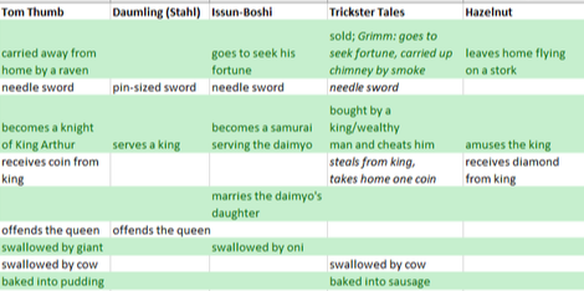
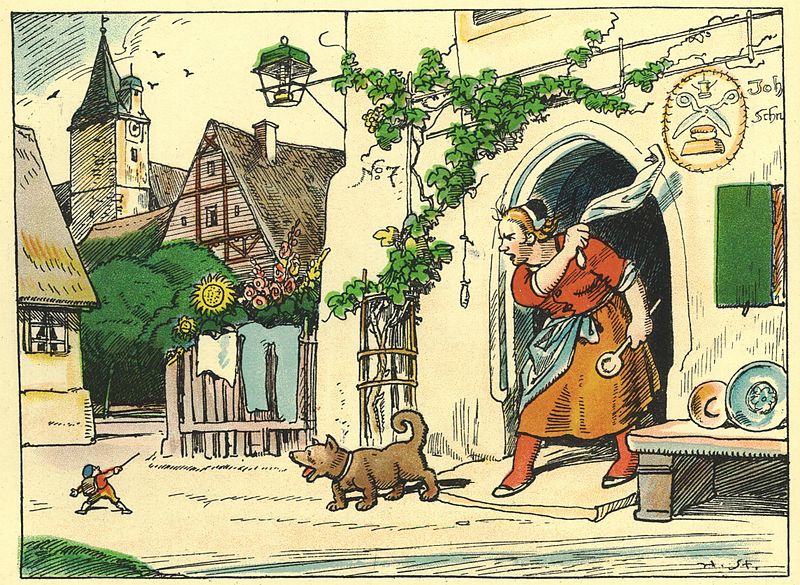
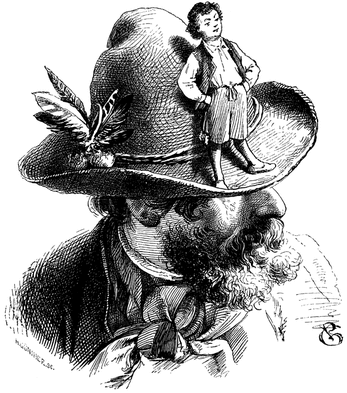
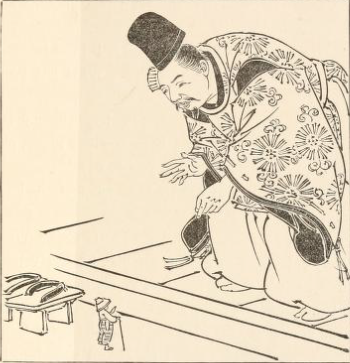
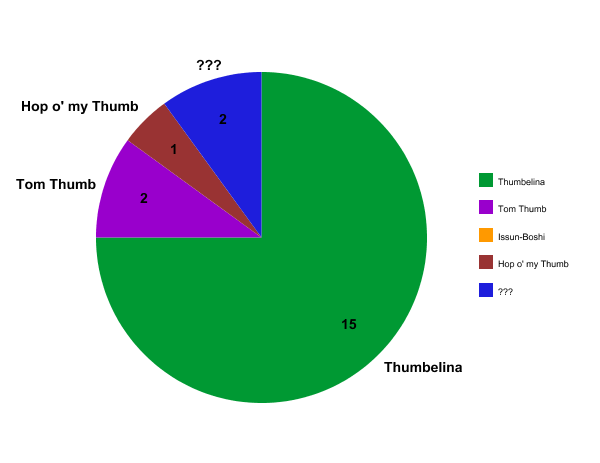

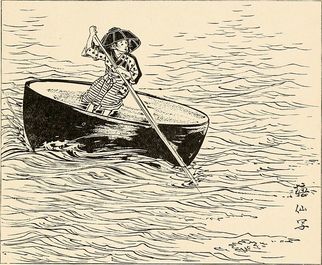
 RSS Feed
RSS Feed
